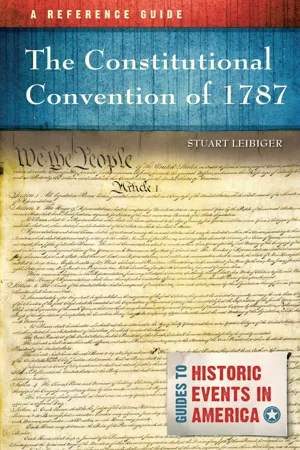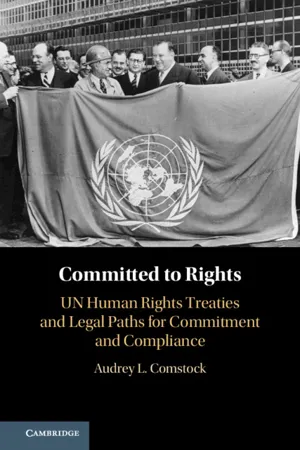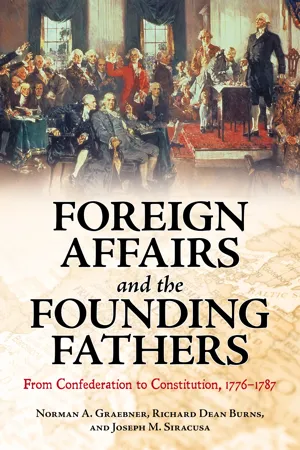Politics & International Relations
Ratification of the Constitution
The ratification of the Constitution refers to the formal approval of the United States Constitution by the states. This process involved each state holding a convention to debate and vote on whether to accept the Constitution. The ratification of the Constitution was a crucial step in establishing the framework for the federal government and shaping the political landscape of the United States.
Written by Perlego with AI-assistance
Related key terms
1 of 5
3 Key excerpts on "Ratification of the Constitution"
- eBook - ePub
The Constitutional Convention of 1787
A Reference Guide
- Stuart Leibiger(Author)
- 2019(Publication Date)
- ABC-CLIO(Publisher)
Ratification, a sophisticated national, regional, and local debate, consisted of thirteen separate contests in thirteen separate states. In each state, the specific issues differed, but the essential question in each state remained whether the Constitution would improve or worsen the lives of its citizens. The Antifederalist opponents of the Constitution warned that eventually power would consolidate in the federal government, resulting in a tyranny. The Federalist supporters of the Constitution secured ratification not only based on the strength of their arguments, but also through skillful political maneuvering. In addition, Federalists possessed significant advantages, such as the backing of most of the country’s newspapers and the support of George Washington and Benjamin Franklin, America’s most influential men. Two turning-point moments in the ratification contest occurred when the Massachusetts convention agreed to unconditional ratification with recommendatory amendments, and when New York’s Antifederalist leaders acquiesced upon receiving news that Virginia had become the tenth state to ratify. In 1789, James Madison proposed a bill of rights and pushed it through the First Federal Congress. Madison acted to reassure Antifederalists, to preclude structural amendments that would have weakened the powers of the federal government, to improve the Constitution by better protecting rights, and to encourage North Carolina and Rhode Island to rejoin the Union by ratifying the Constitution. The ratification of the Bill of Rights by the states in December 1791 reduced opposition to the new Constitution and solidified its political legitimacy.“A greater Drama is now acting on this Theatre than has heretofore been brought on the American Stage, or any other in the World,” observed George Washington about ratification. “We exhibit at present the novel & astonishing Spectacle of a whole People deliberating calmly on what form of government will be most conducive to their happiness.” Washington did not exaggerate. The Ratification of the Constitution, in which a nation of nearly three million people held state referendums on whether to adopt a new, republican form of government, marked a milestone in the rise of democracy unlike anything that had ever happened before.1On September 17, 1787, as the delegates to the Constitutional Convention gathered one last time in the Assembly Room of the Pennsylvania State House to sign the completed Constitution, Benjamin Franklin confidently pronounced the carving on the back of the presiding officer’s chair to be a rising and not a setting sun. But Franklin spoke prematurely. Unless the American people adopted the new form of government, the work of the convention would amount to little more than another failed attempt at political reform. It was by no means clear whether the convention’s handiwork would be accepted. The Ratification of the Constitution, in short, was not inevitable. On the contrary, ratification quickly became a very suspenseful drama with odds changing daily, making the result unpredictable. Decisions reached in early state conventions shaped events in other states whose conventions met later. Ratification illustrates contingency in history, where the events of today shape the events of tomorrow, which in turn shape the events of the next day.2 - eBook - PDF
Committed to Rights: Volume 1
UN Human Rights Treaties and Legal Paths for Commitment and Compliance
- Audrey L. Comstock(Author)
- 2021(Publication Date)
- Cambridge University Press(Publisher)
Aust opines that word choice confusion may stem from politicians: “One also often hears a government minister saying that the state has ‘signed up to’ a treaty. In English, the expression usually means being bound legally, but not always. So, being a loose term, it should be avoided if at all possible” (2007, 115). The terminology of being a state party to a treaty refers to “a country that has ratified or acceded to that particular treaty, and is therefore legally bound by the provisions in the instrument” (UNICEF n.d.). Aust adds that describing a state as a party to a treaty is reserved for when the treaty has entered into force (2007, 114). This expanded definition includes binding commitment actions beyond ratification. When writing about signing on, authors are rarely writing about signature but rather about ratification, which occurs after states sign treaties. Beyond linguistic opaqueness, the lack of precision in legal commitment terminology creates a disjuncture between what is conceptually and legally being written and what is being measured, tested, and used to evaluate arguments related to international human rights law. The following discussion delves into what we know from the literature about international law, illustrates how it has centered on ratification, and clarifies some of the language used by prominent studies. Studying Compliance: Using Ratification as a Critical Point of Departure Beginning with Keith’s (1999) article “The UN International Covenant on Civil and Political Rights: Does It Make a Difference in Human Rights Behavior?” scholars have built quantitative analysis around the questions of when and why states commit to international human rights law and whether or not states comply with the law following commitment. Before this time, as Hathaway notes, “the question of international law compli- ance fell by the wayside of both international law and international relations scholarship” (2002, 1942). - eBook - PDF
Foreign Affairs and the Founding Fathers
From Confederation to Constitution, 1776–1787
- Norman A. Graebner, Richard Dean Burns, Joseph M. Siracusa(Authors)
- 2011(Publication Date)
- Praeger(Publisher)
Chapter 7 THE RATIFICATION DEBATE: HOW IMPORTANT IS FOREIGN POLICY? On September 17, 1787, the Constitutional Convention convened for the last time in Independence Hall, Philadelphia. Of the initial 55 members, 38 were present; the others had left to either resume other tasks or to exhibit their displeasure with the emerging document. As Secretary William Jackson read the engrossed document for the last time, few, if any, were totally pleased with the frame of government they were about to propose to the American people. It was basically a bundle of compromises preconceived by no one. For the moment, they could suppress their misgivings because they alone knew what dif- ficulties they had surmounted to produce the concededly imperfect design of government. The reading completed, Benjamin Franklin addressed the signers to urge unanimous agreement. As George Washington acknowledged, the Constitution could not satisfy the concerns of all, but he concluded that the document was “liable to as few exceptions as could reasonably have been expected.” Still, three refused to sign—Elbridge Gerry of Massachusetts, Edmund Randolph and George Mason of Virginia. After fixing the procedure for ratification, Washington noted in his diary that members of the Convention “adjourned to the City Tavern, dined together, and took a cordial leave of each other.” 1 It had been decided that the proposed Constitution would be sub- mitted to Congress with the recommendation that state conventions, made up of delegates elected by the people, would ratify the document. As soon as nine states voted affirmatively, ratification would be com- plete, and new government would be elected. On September 28, Congress voted unanimously to submit the Constitution to the states 124 FOREIGN AFFAIRS AND THE FOUNDING FATHERS for action. “This apparent unanimity,” George Washington informed James Madison, “will have its effect.” 2 The ratification struggle moved on to the states.
Index pages curate the most relevant extracts from our library of academic textbooks. They’ve been created using an in-house natural language model (NLM), each adding context and meaning to key research topics.


